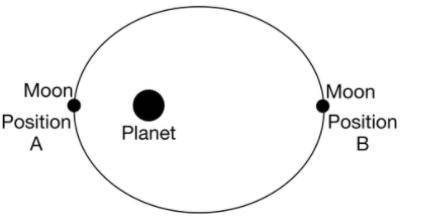
Physics, 02.03.2021 19:40 ansuaprajita1506
The figure above shows the position of a moon that orbits a planet in an elliptical path. Two specific locations of
the moon, position and position , are labeled.
1. As the moon orbits the planet from position to position , is the magnitude of the planet’s force due to
gravity exerted on the moon constant? Why or why not?
A
Yes, because the masses of the planet and moon remain constant.
B
Yes, because the elliptical path that the moon travels around the planet is the same for all revolutions.
C
No, because the tangential speed of the moon is always changing.
D
No, because the moon’s distance from the planet is always changing.


Answers: 2


Another question on Physics

Physics, 21.06.2019 22:40
Consider two metallic rods mounted on insulated supports. one is neutral, the other positively charged. you bring the two rods close to each, but without contact, and briefly ground the the neutral rod by touching it with your hand. show answer correct answer what would be resulting charge (if any) on the initially neutral rod
Answers: 1

Physics, 21.06.2019 23:30
Ablock of mass m = 2.5 kg is attached to a spring with spring constant k = 790 n/m. it is initially at rest on an inclined plane that is at an angle of 28 degrees with respect to the horizontal, and the coefficient of kinetic friction between the block and the plane is k = 0.14. in the initial position, where the spring is compressed by a distance of a = 0.18 m, the mass is at its lowest position and the spring is compressed the maximum amount. take the initial gravitational energy of the block as zero. b) if the spring pushes the block up the incline, what distance, l, in meters will the block travel before coming to rest? the spring remains attached to both the block and the fixed wall throughout its motion.
Answers: 1

Physics, 22.06.2019 02:00
Askydiver weighing 140 lb (including equipment) falls vertically downward from an altitude of 19,000 ft and opens the parachute after 18 s of free fall. assume that the force of air resistance, which is directed opposite to the velocity, is of magnitude 0.55|v| when the parachute is closed and is of magnitude 14|v| when the parachute is open, where the velocity v is measured in ft/s. assume that acceleration due to gravity has magnitude 32 ft/s/s; remember that weight is the product of mass and gravitational acceleration. (a) find the speed of the skydiver when the parachute opens. (b) find the distance fallen before the parachute opens. (c) what is the limiting velocity vl after the parachute opens? (d) determine how long the sky diver is in the air after the parachute opens. (e) plot the graph of velocity versus time from the beginning of the fall until the skydiver reaches the ground.
Answers: 1

Physics, 22.06.2019 19:00
Ahorizontal force of 400.0 n is required to pull a 1760 n truck across the floor at a constant speed. find the coefficient of sliding friction.
Answers: 1
You know the right answer?
The figure above shows the position of a moon that orbits a planet in an elliptical path. Two specif...
Questions







Computers and Technology, 04.11.2019 22:31





Computers and Technology, 04.11.2019 22:31










